Digital Media Winter Institute 2019
SMART Data Sprint: Beyond Visible Engagement
28 January – 1 February 2019
Universidade Nova de Lisboa | NOVA FCSH | iNOVA Media Lab
Project title: Frugal Innovation: Building bridges between engineering education and social entrepreneurship & innovation.
Facilitators: Miguel Amaral and Elsa Caetano
Team Work (alphabetical order): Catarina Mateus | Cristian Ruiz | Pedro Mendonça | Rajesh Sharma |Tona Elizabeth Orifa
Project pitch slides and final presentation slides
Key Findings
Introduction
Research Questions
Research Design
Methodology
Visual Network Analysis
Findings
Discussion
References
Key Findings
- Frugal Innovation is having a deeper penetration into the Innovation space than Jugaad.
- Both terms has different connotations depending on the region, for the case of Frugal Innovation, this has a strong presence in Western conversation, mostly with an optimistic view, while Jugaad has a wide variety of associations, mainly in the Indian Subcontinent, from exotic “hack” solutions to entertainment.
Introduction
The need to critically apply technology to the social and climatic challenges of today compels us to reconsider our approach to innovation. Among the less orthodox developments in the innovation field we find Frugal Innovation, a commitment to innovation that combines efficiency of resources and new consumption styles that curb consumerism’s impact on the environment and whose products are easily developed, exported or transferable to resource-scarce regions.
So far, however, achievements and breakthroughs in the field of frugal innovation are confronted with a heterogeneous bundle of obstacles to their dissemination and adoption. Most of these obstacles are directly related to the controversial history of the term but another important source of hindrance is the inability to penetrate the traditional fora of innovation.
The mission to create thriving communities of frugal innovation begins with education, ranging from engineering programs to social sciences, and the first barrier to reform is the negative or less appealing outlook granted to this approach. The goal of this project is to take the initial steps towards the creation of the progressive and positive perspective that it deserves. This task necessarily begins with a clear presentation of the concept, so that we may easily classify which products rightfully bear the label of frugal innovation, and which are free riding the wave, however flimsy and small. Because of the simultaneously scattered and global nature of frugal innovation products, the right place to start is the world wide web. This project draws from the digital methods’ toolkit to establish a picture of global conversation around frugal innovation, additionally, intends to perceive how far those concepts are penetrating the innovation space itself.
Negativity associated with frugal innovation has a complicated history. The conceptual indeterminacy of the term gets in the way of straightforward queries on all matters regarding its online presence. Frugal Innovation is the accepted English translation of the Hindi term “Jugaad”. Jugaad is essentially a work-around a daily problem with candid and generally surprising innovative flair or, in other words, a “hack”. Other countries may equally have their own brand of Jugaad but the Indian term came to prominence on account of the widespread Jugaad solutions to the everyday troubles of poverty. Eventually the term was reclaimed as a celebration of inventiveness in adversity. In India Jugaad is a contested term whose meanings vary with caste, class, gender and region.
The goal of this project is thus to disentangle the “hack” aspect of frugal innovation as groundwork for future endeavours in categorization of products and technology. The research questions are designed to establish both the myriad of meanings present in discourse on frugal innovation and the way its products and companies are perceived within the field of innovation at large.
Research questions
- To what extent Frugal/Jugaad penetrates the innovation Space?
- Which products are being presented as frugal innovation?
- Are product manufacturers, entrepreneurs and organizations linked with each other?
- What is the conversation around frugal innovation, and which actors are involved in it?
- Does the different terminology on frugal innovation reflect conceptual variation?
- To what extent are particular Products showcased when referring to Frugal Innovation vs. Jugaad?
- To what extent are particular Organizations showcased when referring to Frugal Innovation vs. Jugaad?
Research design visual protocol
The research lies principally in a cross-platform analysis approach, in order to get a representative result of the web in relation to our study object. Thought at the beginning in a network analysis approach of actors and products across the web, the design of the research took a change of focus due to the lack of density of this networks and the long consuming time these tasks could represent in the limited period of operation. Then, it was suggested to establish perceptions and meanings around two main concepts of innovation studies, they were “ Frugal Innovation” and “Jugaad”, instead to map actors and products by the internet. Beyond a mere description of the meanings, our attention followed the interest to know how far those concepts are penetrating the innovation space.
To reach these goals, it was suggested a bunch of digital platforms, from social media to wikipedia and google, as is shown in the following table:

Figure 1: Schematic representation of the dataset visual protocol
The variety of datasets goes from images, as in the case of Instagram or Google, to discourses and content creation, such is the case of YouTube and Wikipedia, but always around the same two concepts “Frugal Innovation” and “Jugaad”.
Methodology (methods, tools, approaches to data analysis)
Using the DMI tool, Lipmmanian Device (Google Scrapper) to explore the extension of frugal/jugaad innovation on the innovation space, we obtained the top 1000 results for the query innovation. Then, with the DMI tool, Harvester it was possible to extract only the host domains from the URL’s. With this list we were able to cross, using again the Lipmmanian Device (Google Scrapper), and perceiving the interactions and the predominant websites for each theme (frugal and jugaad innovation). The visualization analysis was done using Excel.
In a second phase of exploration on google, we aimed to look into the products and organizations related with the frugal and jugaad innovation field. Firstly, two lists with the 20 frugal products and the 10 most relevant organizations were done manually through online research. Then, similarly to the aforementioned, we scraped the 25 top ranked URLs for each query (frugal/jugaad), and crossing these results we extracted data in order to perceive the presence of each term in the websites, as well as its type and category. Lastly, we organized the visual analysis of the content by word clouds, using TagCloud.
- WIKIPEDIA
From the first approach on Google, we started realizing that “frugal innovation” and “jugaad” do not have the same meaning. Thus, to explore these differences, we did a cross-platform analysis. Starting by Wikipedia, we extract articles by language and categories, using DMI Tool Wikipedia categories scraper for the terms “jugaad” and “frugal innovation”.
Then, to do a cross lingual analysis, we categorised the outcomes for every respective language, and with Gephi we developed a network to show the perception and conceptual relationship between them.
- YOUTUBE
In the case of YouTube, the initial idea was focused in finding the community of content creators, but due to the lack of relevant findings, the exploration was more centred in the content seeing in the platform through the search box. One more time, the keywords to study were “Frugal Innovation” and “Jugaad”. To do this, it was required the use of YouTube Data Tools, from the same DMI. Using the videolist module, extracting by search query 10 iterations, getting a result of 500 videos. After this, it was took into account only the ten first videos to visualize and then analyse popularity of videos and their respective channel owners. To visualize it, it was use Rawgraphs.
The dataset was extracted through DMI Twitter Capturing and Analysis Toolset (DMI-TCAT), this time using the search queries “#FrugalInnovation”, “#jugaad”. For each of these two networks, we created two version: One with this keywords (right side of each slide) and another after removing the hashtag. Then it was applied a visual network analysis, evidenting which hashtags were related to our main concepts on this platform. The main intention was to establish a dominant voice in the whole conversation across Twitter.
Regarding Instagram, we use Instagram Scrapper to retrieve images for hashtags. Once again, one query was “frugalinnovation”, and the other was “jugaad”. Using ImageSorter we analyse 367 images regarding the hashtag frugal innovation, and 542 images concerning jugaad.
Findings
From the top ranked websites scraped, we can conclude that Frugal Innovation has a higher presence (N=1811), compared with Jugaad (N=716) in the innovation Space (top 100 websites mentioning the word “innovation”). We can also accomplish, by analysing the graphics below:

Figure 2: Frugal innovation presence in websites
Websites addressing more “Frugal Innovation” are, in general, connected to:
- Business (Forbes, HBR);
- Consultancy (Accenture, Mckinsey);
- Online information and Academia (Wikipedia, UNL, UC);

Figure 3: Jugaad presence in websites
Websites addressing more “Jugaad” are, in general, connected to:
- Social Networks/ Online communication (Twitter, TED);
- Business (Forbes, HBR) (a lot less than Frugal Innovation);
- Policymaking (EC);
When addressed with the question “To what extent are particular Products showcased when referring to Frugal Innovation vs. Jugaad Innovation?”, we can verify by the pictures presented below, that in the frugal innovation space there is a prevalence of sites related to academic fields.

Figure 4: Sites relevance and products presence in frugal innovation space
Whereas, in jugaad space, it is visible its occurrence more frequently in social networks. However, regardless of whether it is in frugal space or jugaad, it is possible to conclude that the products mentioned more often in websites are mostly coincident in both scenarios.

Figure 5: Sites relevance and products presence in jugaad innovation space
Similarly, in response to the question “To what extent are particular organizations showcased when referring to Frugal Innovation vs. Jugaad Innovation?”, we divided the organizations into three categories, namely nonprofit organizations, hubs and start-ups. It is visible through the word clouds presented that, not only in frugal innovation space but also in jugaad, the most significant organizations are nonprofit organizations, followed by hubs, and finally, the smallest presence is in startups.

Figure 6: Organizations presence in frugal and jugaad innovation space
- WIKIPEDIA
To understand the perception of the studied concepts along this project, in the Wikipedia experience, it was built a network based on the categories the Wiki labels articles. It seems that Jugaad articles exist only in Japanese, Spanish, Hindi and English. And in the case of the topic “Frugal Innovation” there are articles in French, English, German and Portuguese.

Figure 7: Manual-built network created through labels of wikipedia articles per language of the concept “Frugal Innovation”.
It seems that every language has its own perception of the concept. In the image 7, we can visualize a network that links similar concepts, (FR-EN: Engineering concept FR-GE-PT: Innovation ) but that also shows perceptions of the main concept in every language. In French for example, it is possible to see that Frugal Innovation is more related with economic theory and in the English side, it is more perceived as Engineering concept, but also related to poverty. Finally in the case of German and Portuguese, the word is understood in an innovation-related line.

Figure 8: Manual-built network created through labels of wikipedia articles per language of the concept “Jugaad”.
The same methodical process was repeated for “Jugaad”, that in its case were strongly related to the indian subcontinent culture and customs (Indian slang – EN; Indian Culture – JP), but every language has their own ways of interpretation. The only connection between languages was ES-JP, considering Jugaad as an hindi but also a business concept.
- YOUTUBE
The YouTube experience suggested, as can be seen in figure 9, that the dominant voice was principally, traditional media, like BBC, The Economist, France 24 ect, Ted talks and academic related channels for the case of Frugal Innovation.
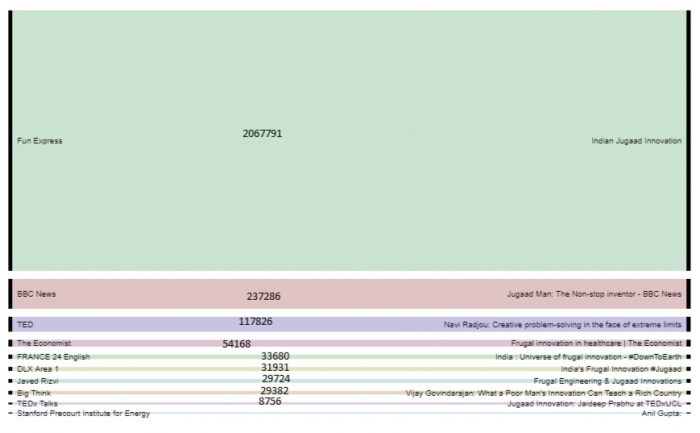
Figure 9: Rawgraphs visualization of the videolist the top ten videos and its respective channel user owner given by the YouTube Data Tools with the keyword “Frugal Innovation”.
Videos are related to reportages, frequently considering the frugal as a optimistic option to fight poverty and underdevelopment. Curiously, the most watched video, is owned by a channel dedicated to funny videos, with a content that consider this sort of innovation as something exotic and funny.
As can be seen in figure 10, in the case of Jugaad, the content was strongly dominated by video-compilations of laughing in relation with the concept. Videos normally show a sequence of funny images on how a life situation was “hacked” to find a solution with precarious objects. Another content, in the top ten, is related to a movie apparently with the same name.
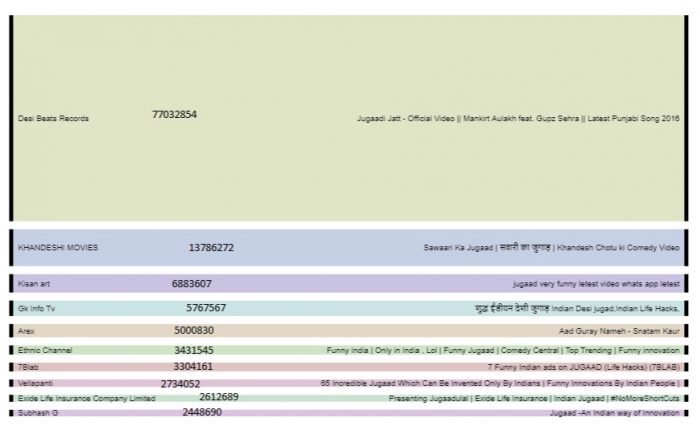
Figure 10: Rawgraphs visualization of the videolist the top ten videos and its respective channel user owner given by the YouTube Data Tools with the keyword “Jugaad”.
From here, one could suggest that the world has a more optimistic meaning in western countries. Maybe due to the promotion of big media and that in the asiatic subcontinent of india, it seem more related with funny and exotic solutions with precarious objects, but not took as an option to solve challenges of these societies.
Following the path of exploration, in the case of Twitter, the co-hashtag network visualization for #Frugalinnovation showed a small network very connected to entrepreneurship as can be verified in figure 11:
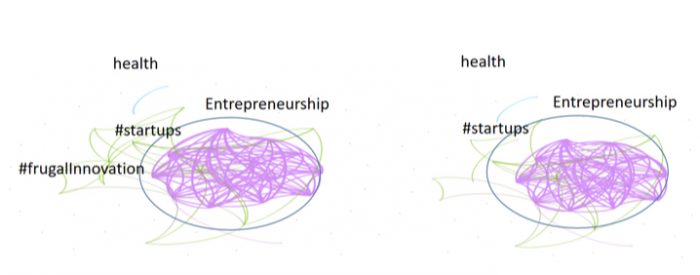
Figure 11: Co-hashtag network in twitter with hashtag “#FrugalInnovation”
The term Frugal Innovation is more meaningful however, less widely used especially in Indian which was the main region of our analysis. We did find tweets having the term “#FrugalInnovation”. As expected the network is relatively sparse compared to Jugad network. We identified three main subregions related to Entrepreneurship, StartUps and Health.
The appearance of these three terms is meaningful as Frugal Innovation, which is more sophisticated and proper term to address economical solutions (rather than adhoc solutions, for which “Jugad” is used).
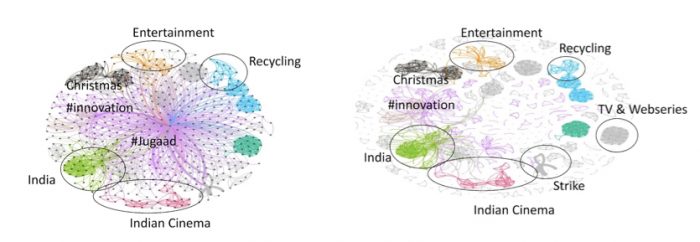
Figure 12 Co-hashtag network in twitter with hashtag “#Jugaad”
On the other hand, #Jugaad showed a much bigger graph with a lot of topics not related to innovation, like strikes, TV and indian cinema, not really connected to each other. Figure 12 shows also, how when the #Jugaad is removed, one can see that the network disintegrates very badly (at least visually) after the removal, which seems to make sense, but it is interesting how subnets keeps conhesionated in spite of the lack of our main concept.
Lately, exploring Instagram, with the same dynamic of co-hashtag. We found for the #FrugalInnovation case that there are several communities connected through this word, showing a density that allows to remove the hashtag and still keep cohesion into the network.
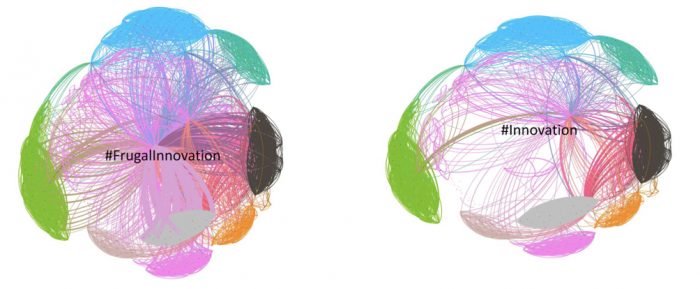
Figure 13 Co-hashtag network on instagram with hashtag “#FrugalInnovation”
The co-hashtag for #Jugaad showed communities connected with different issues, as in the case of twitter, most of them not connected with Innovation.

Figure 14 Co-hashtag network on instagram with hashtag “#Jugaad”
Also, figure 14 shows how dense the network is, even without our main concept. A wide bunch of hashtags are around, from #Thinking to #recycled or #Creativity, which at a first sight seems to be quite optimistic when relationate Jugaad with other concepts.
Discussion/Conclusion
Regarding the analysis performed in google, it was possible to conclude that frugal innovation has a greater presence in the space of innovation compared to jugaad. This can be explained due to its greater prevalence in business sites and academic fields, while jugaad appears mostly in social networks and communication channels.
But also, after the path followed through many experiences in the cross-platform analysis for the two main terms, #FrugalInnovation and #Jugaad, one can suggest a differentiation in connotations of every word, as for example in the case of Wikipedia and Youtube, it can be seen a regional difference between Indian Subcontinent and Western. It seems that frugal innovation is a translation of only part of the meaning of jugaad, trying to avoid the “bad” connotations related to low quality and presenting it as an answer to the future. It is interesting how, while videos on YouTube for “Frugal Innovation” are frequently related to optimistic reportages of big liberal media as the Economist, videos of Jugaad case are commonly content-creation of funny intention of the “hacks” people do with precarious objects and limited production resources.
In the case of twitter and Instagram, the network of Jugaad is very tight, but again, we identified a lot of subtopics not related with our expectations of innovation view. Keywords such as 1) Entertainment, 2) Recycling, 3) India, 4) Indian Cinema, 5) Renovation were found. We also found the Jugad in terms of Education, where the students were protesting (strike) and were demanding better solutions and not adhoc education system. Thus, term Jugad is widely used in different context where people use ad-hoc solutions rather than fixed long term solutions. While Frugal Innovation hashtag, were smaller but strongly related to Entrepreneurship.
Suggestion for further research on the topic, could lie in a concentration of studying actors, in both terms to establish a comparison and a deeper understanding of the differences of perception of the concepts.
References
Rogers, R. (2013). Digital Methods. Cambridge, MA: MIT Press.
Venturini T. et al. 2015 (2015). Visual Network Analysis. SciencesPo Media Lab working paper. http://www.tommasoventurini.it/wp/wp-content/uploads/2014/08/VenturiniJacomy_Visual-Network-Analysis_WorkingPaper.pdf
